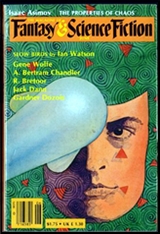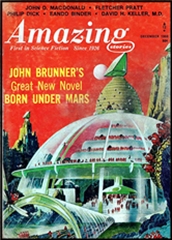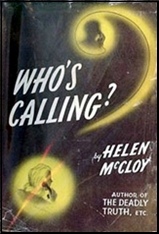August 2023
Monthly Archive
Wed 2 Aug 2023
IAN WATSON “Slow Birds.†Novelette. First published in The Magazine of Fantasy & Science Fiction, June 1983. Reprinted in The Year’s Best Science Fiction: First Annual Collection, edited by Gardner Dozois, and The Best Science Fiction of the Year #13, edited by Terry Carr. Lead story in the collection Slow Birds and Other Stories (Gollancz, UK, hardcover, 1985). Nominated for both Nebula and Hugo awards for Best Novelette of 1983.

Before starting this review in earnest, a description of the Slow Birds of the title is probably a good idea. The setting isn’t stated, but it appears to a rather cut-off area of perhaps a future United States, but if so, an appreciably altered one. The slow birds are a hazard the small population has learned to live with. They are not alive, far from it. They have tubular metal bodies, rounded in front and tapering to a point in back, about the length of a man and the girth of a horse with small wings used for stabilizing, not for propulsion.
They appear and disappear at random and fly through the air at a constant speed of three feet per minute at the height of a man’s shoulders. Objects they can push their way through, they do. If they can’t, they bank around them. Graffiti on them identifies them, one from another. Eventually one of two things happen. They vanish on their own, or they explode, leaving a circle of flat glass having a radius of two and half miles on the ground below.
One way to describe how well the inhabitants of five villages which lie close to each other have adapted is to tell you about the competition has developed between them on Mayday every year: a windsail/skating race on a circle of glass next to one of the villages. Jason Babbidge, the story’s primary protagonist has hopes of prevailing against last year’s winner, but as told in some detail, he fails.
It’s the detail that matters, not necessarily that he fails. Later the same day, Jason’s younger brother climbs onto one of the slow birds, determined to learn, once and for all, where they go when they vanish, only to appear again later. Does he survive the trip? It takes a lifetime for him to return again, with finally an answer.
When I started this review I was going to tell you what he learned, but now I have decided not to. You may have some idea what the slow birds and why they do what they do, and I did as well. What I did not expect to happen is to have the story turned inside out in such a cosmic mind-blowing fashion, from the scale of a small annual semi-friendly competition to what I will tell you is the exact opposite.
If ever after I finished a science fiction story by saying to myself “Wow,†this one was it.
Five stars.
Tue 1 Aug 2023

JOHN BRUNNER – Born Under Mars. Ace G-664, paperback original, 1st printing, [October] 1967. Cover art by John Schoenherr. Reprinted several times. Serialized previously in two parts in Amazing Stories, December 1966–February 1967.
Ray Mallin is a Martian, and a space pilot whose last voyage brought him to the attention of three factions. After the colonization of Mars, the stars [?] were settled by two spheres of influence: the Bears in the north, the Centaurs in the south. The third group consists of Earthmen and Martians interested in improving the genetic structure of all mankind.

A stolen baby is the key, and [the way Martian society has developed] provides the means of getting him back again.
The science is that of sociology, The separate distinct cultures did not form by accident. But because certain traits are dominant in a society, [it should not be assumed that] all members of that society have that same trait.
The story itself is dreary, reflecting the dreariness of a stagnant Martian culture. Or is sociology itself not particularly interesting? A standard plot with a good point of view.
Rating: ***½
— April 1968.
Tue 1 Aug 2023
Posted by Steve under
Reviews[11] Comments

HELEN McCLOY – Who’s Calling? Basil Willing #4. William Morrow, hardcover, 1942, Dell #151, mapback edition [1947]; cover art by Gerald Gregg.
Dr. Basil Willing, Helen McCloy’s primary (and only) series character appeared in thirteen novels between 1938 and 1980, and at least two short stories. Willing may have the distinction of being the first psychiatrist detective, having a formal connection with the NYPD and perhaps as well with the FBI, and being called upon to help solve cases in which his professional knowledge might come in handy.
This one begins with a voice on the telephone warning New York night club singer Freda Frey not to accompany her fiancé Archie Cranford down to meet his mother who lives in a small town outside of Washington DC. She goes anyway, in spite of the phone call and in spite of an unspoken hostility from her future mother-in-law, who fears that Archie will settle for less in his life if he marries her.
Freda is not the victim of a killer, however. Dead instead is Chalkley Winchester, a long lost cousin of Mrs, Cranford and the fussy kind of a man that reminded me of Truman Capote, say, but several years before the latter’s time.

Working on a degree is psychiatry himself, it is Archie who calls in Dr. Willing to help the police, an event that doesn’t occur until perhaps a third of the way through the book, and it is his expertise that helps determine that the killer is suffering from a split personality disorder. What may make this mystery unique in the annals of detective fiction is that while Willing nor the police know who the killer is, neither does he or she as well.
I confess I do not know why the killer was continually referred to as a poltergeist. As I understand the term, that is a undead spirit which manifests itself by making noises in the night and throwing crockery against the wall.
Setting aside most of the psychiatric background of the case as only pleasant background noise,, which I did, this is a well-constructed detective puzzle in which all of pieces fit snugly together at the end, against a backdrop of upper middle-class gentility that not so incidentally is part of the killer’s motivation, a nice touch. Not a work of classic stature, say, but it’s one that will do until one of that magnitude comes along.
« Previous Page




